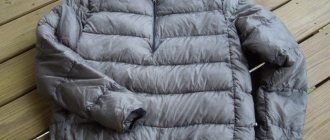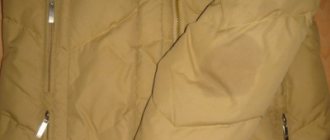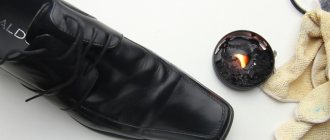Fuel oil stains on jackets and workwear are a relatively common problem. In addition, such complex contaminants may appear on other clothing and accessories. Traces of petroleum products and fuel oil have been bothering women, probably since the invention of oil-based lubricants.
Some jobs involve contaminating clothing with fuel oil or other parts of the oil industry. Trouble in the form of a stain can occur to any of us. Is it necessary to go to dry cleaning in this case? How to wash fuel oil from a jacket at home?
Fuel oil contains many types of resins and asphaltenes. They are poorly soluble in gasoline, alcohol or acetone. A rhetorical question arises: is it even possible to clean a fuel oil stain?
It is clear that during normal machine washing the fuel oil stain will not come off. To remove it you need to use a trick or some home remedies. Of course, there are no universal preparations that act on fuel oil stains, but any housewife can find several remedies in her arsenal. You can try using them to clean your favorite item.
What to do with dense products?
The first place in the list of items most often contaminated with fuel oil is shared by the overalls of car service workers and ordinary jeans. All of them are sewn from durable, dense fabrics that are quite resistant to aggressive influences. How can you remove fuel oil from clothes of this type? To clean work overalls, jeans and jackets, you can use stronger products that can also cope with old and extensive stains.
Gasoline (also kerosene, diesel fuel)
A fairly aggressive, but proven method of removing fuel oil stains of any age. The only condition is that only pure gasoline sold in hardware stores is suitable for treating contaminants. A regular one, from a gas station, will be much less effective.
Procedure:
- Place a piece of thick fabric or paper folded in several layers under the stain. A cotton swab is generously soaked in gasoline and the dirt is carefully wiped off, changing the cotton as it darkens.
- Next, the item is soaked with washing powder and stain remover, rubbed by hand and rinsed several times in warm water. Finally, wash in the machine on the “For heavily soiled items” mode.
If the clothes are very dirty, you can soak them entirely in gasoline for 30-40 minutes. Then process as described above.
Thick fabric, from which workwear is usually made, can be easily cleaned with any household chemicals. With gasoline, toluene or solvent, you can even cope with heavy fuel oil.
Toluene
The most effective, and at the same time the most toxic remedy. It is extremely rare on sale in its pure form, but is included in many paint and varnish solvents. The method of working with toluene is similar to treating fabric with gasoline.
Car shampoos
Designed specifically to combat serious stains. You can purchase them at any auto parts and accessories store. The procedure for cleaning clothes with shampoo is similar to most of those described earlier. A little product is applied to the stain, rubbed in and after 30 minutes of soaking, washed first by hand and then in a machine. At the last stage, if desired, you can add a little stain remover powder.
Acetone
A very strong solvent, which is recommended to be used only in the most extreme cases, with serious and extensive contamination. Apply in the same way as in the case of working with gasoline
It is important to remember that acetone can corrode fabrics of synthetic origin and change the color of other
Homemade cleansing paste
Starch, ammonia, turpentine and white clay together cope with complex traces of fuel oil no worse than gasoline and other aggressive agents. To prepare a cleansing paste, they are mixed in equal proportions, the paste is then applied to the problem area of clothing and left for 1-2 hours. The dried mass is cleaned off with a stiff brush, and then the item is washed as usual.
Cleaning denim
The structure of jeans is very strong; when fuel oil comes into contact with the material, the compound is firmly and deeply eaten into the fibers. To clean the fuel oil and return your jeans to their original appearance, take note of a simple cleaning method:
- prepare an effective mixture containing turpentine, ammonia and starch in equal proportions. Add starch last as the mixture thickens. The consistency should resemble a paste, then it will be easier to apply;
- Apply the resulting mass in a thin layer to the affected area, leave the product to act for 10-15 minutes so that it is better absorbed into the rough denim material;
- after the time has passed, dilute vinegar in cool water (for 1 liter, 5 tablespoons of 9% vinegar), soak a cloth in it and remove the remaining mushy mass from the jeans;
- wash the product in warm water with added powder.
In case of severe contamination, the method with ammonia and turpentine is unlikely to help; all that remains is to remove the stain using white spirit or acetone.
Jeans and thick workwear fabrics
Clay paste can easily remove traces of fuel oil from jeans and work clothes. To prepare it, you need to take 90 g of potato starch, 100 ml of ammonia, 100 g of turpentine and 100 g of clay. The resulting paste is applied to the stain and left for 2-3 hours. Then it is cleaned with a stiff bristled brush. After removing stains, items can be washed.
The dense fabrics from which work clothes are made are not afraid of aggressive chemicals. To clean them, you can use gasoline, kerosene, and diesel fuel. Their oily composition helps to dissolve machine oil and completely remove it. It is better to carry out processing from the wrong side of the material. After the stain is gone, it is advisable to rub the fabric with laundry soap and then wash it.
Car shampoos and food products such as margarine or butter work well on dense and coarse fabrics to remove fuel oil stains.
Methods for removing fuel oil stains
There are a lot of household products that will help you wash off fuel oil quickly. When cleaning at the beginning, use the most gentle methods, as they do not spoil the material and preserve its color. If nothing works, and the fuel oil still remains on your clothes, then proceed to radical methods of struggle. In any case, the stain will be less noticeable, and over time, after repeated washings, it will disappear completely.
Gentle methods
To remove fuel oil from delicate fabrics such as silk, cotton, synthetic material, you need to use methods with a mild cleaning effect. They definitely won’t harm clothes, and are very effective in terms of efficiency. Gentle methods are based on the cleaning power of the products. It helps to “push” the petroleum product out of the fabric base without damaging the fibers themselves or destroying the color.
Dishwashing liquid
As a quick fix, a small oil stain placed on clothing recently will help remove Fairy. Instead of “Fairy”, any dishwashing detergent with a gel structure is suitable: “AOS”, “MYTH”, “Pril” and others. Drop a little liquid onto the stain, leave for 10 minutes, and then thoroughly wash the item and rinse it several times. You can wash it by hand with laundry soap if the item is small. When the item dries, there will be no fuel oil on it.
Baking soda
It is better to use soda to remove traces of fuel oil from light or white fabric. because it has a whitening effect. Prepare a thick paste from baking soda and water, spread it with a spoon into a thin layer over the fuel oil and leave for 10-15 minutes. When a crust forms on the surface of the fabric, scrape off the dried soda from the fabric and rinse the item itself in water several times.
Essential oil
Any oil you find will do: fir, eucalyptus, orange, lemon, etc. In addition to the oil, you will need a cotton swab or disk. Soak a thin layer of cotton wool in essential oil and rub it repeatedly over the area contaminated with fuel oil. When the disc becomes dark, take a new one. Swipe over the surface again and again until the stain is completely gone.
Ammonia
Ammonia will help deal with small, recently contaminated areas. Apply ammonia to the stained area using a cloth soaked in it. Change the cloth napkin for a fresh one if the old one is already dirty. Then rinse the item in plain water, replacing it with fresh water several times.
On a note! To rid clothes of the pungent smell of ammonia, add a few drops of essential oil or a capful of fabric softener to the water when rinsing.
Radical methods
To clean coarse textile fibers, fuel oil contaminants are easily removed by solvents, its organic derivatives, and auto chemicals. All methods are aggressive, and before cleaning, it is better to test the product on a small area of fabric in an inconspicuous place. If the material has not changed its structure or become discolored, then you can continue cleaning.
Auto chemical goods
Car shampoos and car showroom cleaning products will be useful not only in the garage, but also at home. They contain organic matter that removes traces of fuel oil compounds. You must use auto chemicals in strict accordance with the instructions, since the composition of the products is potent and can damage the fabric if used incorrectly. After cleaning with auto chemicals, be sure to wash your clothes in powder several times.
Caustic soda
If you have caustic soda in your home, take 200 g of powder and dissolve it in 10 liters of water. Soak the contaminated item in a freshly prepared solution for a couple of hours, then wash it twice. If the stain has been there for a long time, then rub baking soda on the contaminated surface, add a little water and wait 15-20 minutes, then repeat cleaning as described above. You can replace soda with laundry soap, first rubbing it on a fine grater for better dissolution.
Jackets and down jackets
Jackets and down jackets are difficult to clean. Their fabric, despite its apparent density, is made of synthetic fibers and is easily damaged by aggressive agents.
Among the available substances to combat fuel oil stains on winter clothes, you should choose the following:
- fir or eucalyptus oil;
- turpentine and baking soda;
- tar or laundry soap;
- dishwashing gel.
Treatment with essential oil has proven to work best. The substance helps to liquefy fuel oil even on delicate fabrics. After removing the stain, dishwashing gel or stain remover for colored fabrics will help remove the greasy residue.
Contaminants can also be removed with car shampoo or clay-based paste, but before using these products you should check their effect on the fabric from the reverse side of the product.
Insulated workwear is made from denser synthetics, so both turpentine and acetone can be used to remove contaminants.
Folk remedies
Have you tried chemo but it didn't work? Or just don't like chemicals? Folk remedies will help you.
Salt
Salt only removes fresh oil stains!
Apply salt to the stain, drop a few drops of water on it, and wait a little (about 10 minutes). Then rinse off the salt and wash the product.
Lemon
Apply lemon juice or a stronger combination of juice and salt directly to the stain. After 10 minutes, wash your clothes. On some materials, greasy dirt will be completely removed, on others it will be significantly lightened.
Vinegar
When dealing with unsightly stains that are difficult to remove, water (1 l) with vinegar (5 tbsp) and detergent (2 tsp) helps. Soak the product in the solution, leave it soaked overnight, and wash it in the morning. The spots will disappear or at least fade significantly. Repeat cleaning if necessary.
Car shampoo
Car shampoo carefully cleans the fabric from machine oil without damaging it. You can purchase the product at any auto parts store.
If the mark has already dried, you will first have to soften it with margarine or butter. Then apply car shampoo in a small amount and gently rub it into the fabric. The clothes are left in this state for 30-40 minutes. Then it is washed in an automatic machine or by hand.
Using an automatic machine
Items treated for oil stains using one of the proposed methods are sent to an automatic machine to consolidate the result.
If gasoline or kerosene was used, wash the product separately from other items. Select a brand of powder that can cope with such a stain. For example, “Bimax 100 spots”. Since fuel oil becomes unstable at high temperatures, the heating limit is set for a specific type of fabric. Household stain removers, such as Vanish, will help remove fuel oil from clothes. Before washing, moisten the stain generously with the product and wait for the required time specified in the instructions.
Methods for removing fuel oil stains from clothes are not complicated and can be done independently. If you do not get the desired result, contact a dry cleaner.
https://youtube.com/watch?v=EIZ4pxHDja0
Caustic soda
Effective but toxic. It should only be used when washing thick fabrics, observing safety precautions. Clothes made of silk and wool cannot be treated with caustic soda.
The first way to remove a stain is to apply baking soda to the stain for 20 minutes. Then the item is washed.
In the second case, soda is diluted in water (2 tablespoons per liter), and the clothes are soaked in the resulting solution for 2 hours. After processing, the item is washed.
Instead of caustic soda, you can try a gas stove cleaner.
Removing fuel oil stains from white clothes
On white material, contamination is very noticeable; caustic soda will help make it less noticeable. Soda has a strong bleaching ability, it will refresh the whiteness, the petroleum product can be washed off the first time. It is necessary to use caustic soda: it is more reactive than baking soda. When preparing the solution, be careful and follow safety precautions: wear gloves and safety glasses. The method of using soda is as follows:
- fill the bucket with water almost to the top;
- Dissolve a glass of caustic soda in water;
- soak the clothes directly in the bucket and leave for 1.5-2 hours;
- wash clothes with soap or powder twice.
For small stains, the method works great. For large fires, especially old ones, first wipe the contaminated fabric with ethyl alcohol or ammonia to degrease the fabric, and then begin cleaning.
How to remove fuel oil from outerwear
A coat or sheepskin coat can be cleaned of fuel oil using aviation gasoline, ammonia, solvent, and caustic soda. You can also use car shampoo or products that are sold in auto supply stores, for example “AXEL” - a professional remedy for grease and oil stains.
You can remove fuel oil from a jacket, gloves, hat or shoes as follows:
- Grind ordinary chalk, if it is not available, use lime;
- Sprinkle the powder onto the stain and rub thoroughly with a brush;
- After a day, remove the chalk and wipe the area with a cotton swab dipped in glycerin.
How can you scrub it off?
Based on the above recommendations, you can easily choose a way to get rid of such an unpleasant situation as a fuel oil stain. It is worth considering a few more important factors that will help you put your favorite things in order without much effort and at home.
With different types of fabric
It is important to remember that there is no one-size-fits-all approach to cleaning different types of fabrics. For example, to combat stains on rough denim, almost any product is suitable
If the stain is small, then an ordinary detergent can remove it without any problems, but if the stain is large, more stringent methods of dealing with it will be needed.
In the situation with jeans, it is quite acceptable to use solvents, acetone and even purified gasoline or kerosene. It is enough just to apply the selected product to the stain and leave for an hour. After this, it will be quite easy to wash it with ordinary soap or washing powder. Such products can only be used with gloves.
In the case of bologna you need to be more careful
To remove a fuel oil stain from your favorite Bolognese jacket, you can also use almost all of the above remedies, but with great care. It’s worth trying more gentle methods first so as not to damage the fabric structure.
It is extremely undesirable to apply friction to it, because intense friction causes the bologna to become very thin and can quickly break through.
In addition, it is quite difficult to see the end result on bolognese fabric, because it has the property of becoming stained and speckled at the slightest wetness, so you definitely cannot do without washing the entire product.
Here only household chemicals and patience will come to the rescue: most likely you will need several washes. You can consider washing with eucalyptus essential oil or ammonia, but even with these products you need to be extremely careful, since delicate tissues can be damaged even by such seemingly harmless substances.
From white and colored materials
It is very difficult to say which scanner is more difficult to remove fuel oil contamination from: white or colored. On the one hand, such a stain is too obvious on white fabric, but on the other hand, when cleaning colored fabrics there is a high probability of losing the color of the product. In the case of white fabric, it is quite acceptable to use high-quality bleach: if the stain is small and fresh, there is a high probability that a simple wash with bleach will be enough. In a similar situation with colored fabrics, there is a good chance of coping with a good stain remover.
In the case of colored fabric, it is very important to carry out a “test” wash - a fading test. To do this, you need to apply a small amount of the selected product to an inconspicuous area of the product: this can be the inside of a cuff or collar or any other place hidden from the eyes of strangers, and leave for a while
From the skin
In the case of leather goods and shoes, things are a little simpler. Due to its dense structure and smooth surface, the skin absorbs fuel oil much less. It is enough to promptly wipe off the fuel oil from the surface with an alcohol-based damp cloth and the problem can be avoided altogether. It is highly undesirable to wash or dry clean leather products, so it is better to minimize the possibility of such contamination.
If the stain has become ingrained and there is a need to remove it, a car interior cleaner will come to the rescue. Car shampoo is designed to combat this kind of stains; it dissolves grease well and removes the remains of burning and soot from the fuel oil.
Minimal chemical intervention may also be considered. To do this, you can try to wash off the stain with laundry soap or alcohol and paint the product with a special paint for leather: this option will not only help clean the product, but will also update its appearance.
Today there are many options for dealing with difficult stains. Long gone are the days when housewives were forced to scrub and boil laundry for a long time
Today, it is only important to choose the right household chemicals and washing machine for yourself, and you can forget about fighting stains. Laundry has become something simple, it is no longer a labor task for women, even in the case of such complex stains as fuel oil stains
In the next video you will learn about another effective remedy.
How to remove an old fuel oil stain on a jacket:
First of all, it is necessary to soften the area of contamination. To do this, use caustic soda, acetone, white spirit, as well as specialized removers.
It is important to limit the area of exposure to the active substance to the stain only, so as not to damage the surrounding tissue.
After the jacket has been cleaned of traces of fuel oil, you should carry out a regular wash, and if the measures taken were not enough, then resort to more aggressive methods of attacking the stain.
We remove heavy stains
If the machine oil stain has frozen, you will need to use more effective means. These include the following cleaners:
Soda and turpentine . To use this simple recipe, you need to heat the turpentine in a water bath or in the microwave. Apply the product with a cotton swab to the dirty area of clothing for half an hour. Then sprinkle with baking soda and scrub with a soft brush. After these steps, wash off the product with soapy water and rinse in a vinegar solution.
Turpentine and ammonia . Place a spoonful of the above ingredients in a glass and heat in the microwave. Apply warm cleaner to the machine oil stain and after twenty minutes wash the clothes in warm soapy water.
Refined gasoline . An effective product for removing fuel oil stains, as it is also a product of oil refining. However, use the cleaner with great caution. Not all types of material can withstand the effects of this solvent. Stains on clothing are treated with gasoline using a cotton pad and left for five minutes to act. To achieve better results, it is recommended to heat gasoline in a water bath. For large machine oil stains, soak clothes in gasoline.
Car shampoo . The product contains a component such as toluene, which is capable of dissolving oils. Using the product you can get rid of all types of household stains. Apply the cleaner to the contaminated part of the clothing for thirty minutes and then rinse with warm water. Complete the cleaning procedure with a simple wash with powder.
Acetone . When choosing, give preference to a colorless product, since the material of the product may change color. Treat the oil stain with acetone using an ear cleaning stick and rinse with running water after ten minutes.
Kerosene . Use only cleaned detergent on clothes. Using a piece of bandage, apply the cleaner to the machine oil marks and scrub a little. Remove marks with soapy water and wash in a washing machine with powder. You can get rid of the unpleasant aroma of clothes after using kerosene with fabric conditioner or a vinegar solution.
Ammonia . You can also use ethyl alcohol and vodka to clean clothes. Treat the stained surface with a piece of cotton wool and leave for fifteen minutes for complete absorption. Then wash the product as usual. If the stain was not removed the first time, repeat the procedure again.
How to remove fuel oil stains from a jacket or down jacket
It will not be possible to completely remove fuel oil stains from outerwear without pre-treatment. Hand and machine wash detergents are not designed to combat the oily residue left by petroleum products. It is necessary to carry out preliminary cleaning, remove fuel oil stains, and then wash the item completely to remove dirt and unpleasant odors.
Selecting a detergent
For washing down jackets and down jackets, it is recommended to use liquid gels, which have good washing properties, but do not get clogged between the fibers of the fabric and are easy to rinse. To give a pleasant aroma and softness to outerwear after removing traces of fuel oil from it, you should use fabric conditioners and fabric softeners.
Difficult types of stains should be removed as soon as possible. Fresh traces of fuel oil can be removed from a jacket using folk remedies or gentle household stain removers. In order to wipe off an old stain, you will have to make a lot of effort. The best way to avoid damage to things is to be careful, wear work clothes and know cleaning methods.
Features of stain removal depending on the type of material
Before you wash old fuel oil from a jacket, you should determine the composition of the material from which it is made, since the fabric reacts differently to cleaning agents.
In addition to this rule, there are other general recommendations for cleaning fuel oil blots:
- It is advisable to wash the stain immediately, before it dries. Otherwise, dirt penetrates into the deep layers of the fibers, making it difficult to remove them.
- When cleaning, only clean materials are used - a scarf, a cotton pad, a napkin. Otherwise, you risk staining the fabric with other types of stains.
- The fuel oil is cleaned with short movements in the direction from the edges to the center to prevent an increase in the area of contamination.
- When using chemicals, it is advisable to first try on an inconspicuous area of the jacket to check the fabric's reaction to the product.
- It is not recommended to use several cleaning methods at once. It is unknown what the reaction of the various ingredients will be to each other.
- The area with the stain should be placed on a flat, hard surface, and a paper towel should be placed under it, so that during the procedure the dirt does not spread even wider.
- Do not machine wash items until most of the stain has been removed.
- Before trying methods for removing stains that are effective but dangerous for certain types of fabric, it is recommended to use home remedies (soda, salt, dishwashing gels).
How to Clean Fresh Stains
If the problem was discovered as soon as possible after its appearance, then the chances of wiping off the fuel and lubricants without a trace are quite high.
Algorithm for removing a recently appeared speck:
- First, blot the stained area with any absorbent material, such as a paper napkin or towel, or a dry, clean cloth. You need to do this several times to absorb the maximum amount of moisture.
- The next step is to clean off any remaining stains. To do this, it is necessary to use bulk products that also have good absorbent properties. These include fine salt, starch or powder. To remove a blot, you just need to generously distribute one of these substances over the dirty area, and then let the moisture absorb for about 20-30 minutes.
- If this method does not help, then you should pour the above solution with dishwashing liquid on top, and then rub it a little with your fingers to form a paste.
- After 30 minutes, remove excess product with a toothbrush and then rinse under running water.
- After this, you can wash the jacket in a machine using regular powder.
Tip: before washing, to achieve the best effect, you should soak the item in warm water with the addition of detergent.
Fighting old stains
There is an opinion that old contaminants that have managed to penetrate deeply into the fibers of the material cannot be cleaned. But that's not true. There are many options for removing even stubborn fuel oil that are quite effective and inexpensive.
Most often, various types of solvents are used for such purposes. They do their job well, but, unfortunately, they have a sharp, specific odor that is not so easy to remove.
Washing in a machine or by hand after careful treatment with similar products is required. At the end of all procedures, long-term ventilation is required to eliminate the unpleasant odor.
Useful tips. What is the easiest way to remove fuel oil from clothes?
Taking into account the fact that fuel oil stains are difficult to remove, you must always be prepared for the fact that even after using all the methods, the stains will remain. For better results, some rules will help you.
- Before using your solution on clothing, test it on a small area of similar fabric.
- You need to be very careful when using acetone to clean any fabrics.
- The cleaning solution should be applied from the edge of the stain to the center. This will help avoid streaks on the fabric.
- If solvents are used for cleaning, use rubber gloves to apply them.
- To avoid leaving an outline of the stain on the fabric, apply the solvent, touching a little on the area near the stain.
- If gasoline or alcohol is used to remove fuel oil stains, you need to dry the treated item as far as possible from open fire.
- To prevent the fuel oil stain from remaining on another part of the clothing, a clean, dense cloth should be placed under it.
- If all the above procedures did not help, and the stain still does not come out, it is better to take the clothes to the dry cleaner.
There, specialists use special products that are not widely available. Professional equipment is also used to remove stains. Dry cleaning will return your clothes to their original appearance.
How to remove using folk remedies?
It is no longer possible to wipe off a dried fuel oil stain with soap and water. Working with old stains takes longer, is more difficult, and the result is not guaranteed.
Ammonia
Ammonia purchased at a pharmacy is suitable for treating stains and splashes from fuel oil. A sponge soaked in ammonia is applied to the stain and left to act for 60 minutes. After this, the item is washed.
Tar soap
Tar soap can be purchased in the household chemicals department. It is produced using birch tar. For processing you will need a brush. It is moistened in water and soaped. As the stain is treated, the brush is washed from time to time and soaped again.
Caustic soda
This product is also suitable for fuel oil, but only if thick workwear and not delicate fabrics are treated.
Application procedure for fresh traces of fuel oil:
Application procedure for removing old dirt:
Refined gasoline
Purified gasoline can be used as a solvent. Moisten a napkin in the prepared product and moisten the area with the stain. After exposure, when the fuel oil begins to separate, use a brush to clean from the edges of the contamination to the center.
We use substances similar in composition
One option for cleaning fuel oil from clothes is to use what is stored in the garage. Fuel oil is a petroleum product. Therefore, it is easier to remove it with a solvent that has the same “origin”.
Petrol
This is the most traditional way to get rid of such a pollutant. It is only worth noting one nuance. To remove stains, it is better to purchase special, purified gasoline. The procedure itself is as follows. Dip a cotton swab in gasoline and wipe the stain with it. The tampon needs to be changed periodically as it becomes dirty.
The procedure continues until the stain completely disappears. If the contamination is too large, you can use soaking. Clothes are placed in pure gasoline for several hours. But this procedure is not suitable for all fabrics.
Toluene
This substance is very toxic and difficult to find in its pure form. But several solvents are produced based on toluene and they are worth using
In this case, precautions must be taken. The entire operation must take place in a well-ventilated area and always wear gloves.
Car shampoo
You can also get rid of such pollution by using car washing shampoo. You can purchase it at a specialty store or ask for it at your nearest car wash.
All of the above methods should not be applied to colored clothing made from delicate fabrics. Both gasoline and toluene can harm such things. Therefore, before removing a fuel oil stain, test the effect of the selected product on a small and inconspicuous area of clothing.











